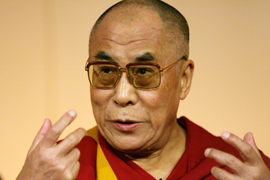China and Tibet: An uneasy past
Uprising poses major challenge for China as it enters Olympic spotlight.

That tough line, which preceded Beijing’s crushing of protests in Tiananmen Square later the same year, helped assure Hu’s rise to the presidency and head of the ruling communist party.
On March 15 China‘s compliant parliamentary gathering, the National People’s Congress, approved another five-year term for Hu as president.
Now an uprising by Tibetans against Chinese rule threatens to present Hu with his biggest test so far – in the very year that China puts itself in the global spotlight as host of the Olympic games.
‘Roof of the world’
The status of Tibet has long been an ambiguous one, in part because of its awkward sandwiching between the ancient civilisations of China and India.
| Tibet key dates |
|
1959 Dalai Lama flees to exile in India after failed uprising against Chinese rule 1960s-70s Hundreds of monasteries destroyed during Chinese Cultural Revolution 1965 China announces creation of Tibet Autonomous Region 1989 Dalai Lama awarded Nobel Peace Prize for leading non-violent struggle for Tibet 2006 Opening of first rail line linking Tibet to rest of China |
China and Tibet have vied for control of the ‘roof of the world’ since they first established contact in the 7th century.
In 1720 China claimed suzerainty over Tibet, but control was often superficial.
There is a well-documented history of Tibetan rulers declaring their independence from China.
But the Chinese say the presence of a Chinese high commissioner as early as 1727 proved Lhasa owed its loyalty to them.
Later Tibet became caught up in the ‘Great Game’ between the British Empire and Tsarist Russia when British troops invaded Tibet and occupied Lhasa in 1904.
The invasion led to a peace treaty between Britain and Tibet, a document some Tibetan historians claim as recognition of their remote mountain homeland as an independent state.
Imperial China was outraged by the invasion but could do nothing to stop it, and waged a diplomatic battle to protect its claims on Tibet.
 |
| The Dalai Lama fled Tibet in 1959 and leads Tibet’s government in exile [GALLO/GETTY] |
Following years of Tibet‘s unsuccessful attempts to gain international recognition as a nation, Chinese communist leader Mao Zedong ordered its “liberation,” and by 1950 Tibet had become an autonomous region of the People’s Republic of China.
This arrangement was an unhappy one, however, resulting in the suppression of an uprising against Chinese rule in 1959 which led to the death of tens of thousands of Tibetans and the Dalai Lama’s flight to his present exile in India.
Today China‘s government insists it is helping to improve and develop what was once a feudal society.
Officials point to rapid economic growth, which they say has seen per capita GDP double over the past five years.
“Tibet is in its best period of development and stability in history,” China’s government-run Xinhua news service quoted Ragdi, a Tibetan delegate to China’s National People’s Congress, as saying.
Economic boost
In 2006 China‘s claims to Tibet were further underscored with the opening of the word’s highest railway linking Lhasa, the Tibetan capital, to the rest of the Chinese rail network for the first time.
China‘s leaders say the multi-billion dollar link provides an unprecedented boost to Tibet‘s economic prospects.
Critics, however, worry that Tibet‘s unique culture will be further swamped by ethnic Han Chinese as the railway brings an escalation of migrants from more overcrowded parts of China.
For several years government economic subsidies have brought an influx of Chinese migrants, under a policy groups like The Free Tibet Campaign group say is part of an increasingly successful ploy to make Tibetans the minority people in many areas of Tibet.
China though is unlikely to abandon its tough approach to controlling Tibet.
Tibet‘s present communist party head, Zhang Qingli, held a series of key posts in the Xinjiang Uygur Autonomous Region in northwest China between 1999 and 2005.
China’s rule over the largely Muslim Xinjiang is in many ways just as controversial and troubled as that over Tibet, but the issue receives much less international attention.
During his time in Xinjiang, Zhang was credited with introducing tough policies to suppress any opposition to Chinese rule.
In May China’s official media quoted Zhang as warning that the Dalai Lama was joining forces with what he called separatists in Xinjiang and Taiwan – as well as democracy activists and the banned Falun Gong religious group – to “split the motherland.”
